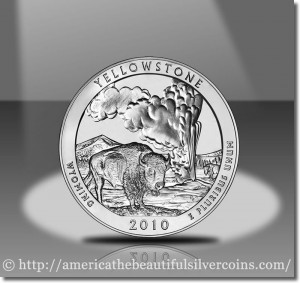The 2010 Yellowstone America the Beautiful Silver Uncirculated Coin is the second release in a series of .999 fine silver collector coins issued by the United States Mint. This particular strike honors Yellowstone National Park of Wyoming with a design showcased on its reverse.
Sales of the Yellowstone Silver Uncirculated Coin began on May 17, 2011. In just sixteen days, the entire mintage of 27,000 had been ordered by the public leading to a sell-out.
This series of coins are issued as the numismatic versions of the America the Beautiful Silver Bullion Coin™ Program. They feature similar specifications including being struck from five ounces of .999 fine silver and a diameter of three inches. Each also contains edge incused lettering indicating the coin’s weight and fineness of .999 FINE SILVER 5.0 OUNCE.
Some of those specifications may change after the inaugural year releases, however. The initial authorizing act for the bullion strikes (America’s Beautiful National Parks Quarter Dollar Coin Act of 2008) dictated the diameter and edge incused lettering. However, subsequent legislation has modified those demands to state that the diameter may be between 2.5 and 3.0 inches, and dropped the edge incused weight and fineness requirement altogether. As such, strikes beginning in 2011 may feature different specifications than those of the 2010 strikes.
Both the bullion and uncirculated silver coins feature designs similar to those found on the circulating America the Beautiful Quarters® Program. Accordingly, the obverse of each strike includes a portrait of the first President of the United States, George Washington. The portrait was designed by John Flanagan and used by the US Mint initially on the circulating 1932 quarter dollar. It has been featured on the quarter dollar in one form or another ever since.
The reverse of the strikes are emblematic of selected sites of national interest from around the United States. Fifty-six sites have been chosen including national parks, national memorials, national forests, etc. with one site representing each state, the District of Columbia and the five US Territories. A total of five year-dated strikes will be released annually under the program until it is completed in 2021.
On the reverse of the Yellowstone Silver Uncirculated Coin, an image representing Yellowstone National Park is featured. It shows the iconic Old Faithful Geyser mid-eruption. In front of and in back of the geyser, two American Bison are shown. The design is the work of U.S. Mint Sculptor – Engraver Don Everhart.
As a numismatic product of the Mint, the coins will be struck to uncirculated quality indicating they will have a higher level of detail than will be found on their sister bullion coins. Also, the uncirculated coins will feature a P mintmark showing they were struck at the US Mint’s facility in Philadelphia. Bullion coins carry no mintmark.
Another difference between the collector and bullion coins is how they are distributed. The bullion coins make their way into the market through the Mint’s network of authorized purchasers which obtains the strikes in bulk, then resells them for a small premium above the current spot price of the precious metal contained within them. The uncirculated coins are sold directly to the public by the Mint.
The Yellowstone Silver Uncirculated Coins have a release window of first quarter 2011.
Yellowstone National Park in Wyoming
Yellowstone National Park was created as the first national park in the world when President Ulysses S. Grant signed the authorizing legislation on March 1, 1872. In part, the Act read:
An Act to set apart a certain tract of land lying near the headwaters of the Yellowstone River as a public park. Be it enacted by the Senate and House of Representatives of the United States of America in Congress assembled, That the tract of land in the Territories of Montana and Wyoming …. is hereby reserved and withdrawn from settlement, occupancy, or sale under the laws of the United States, and dedicated and set apart as a public park or pleasuring ground for the benefit and enjoyment of the people; and all persons who shall locate, or settle upon, or occupy the same or any part thereof, except as hereinafter provided, shall be considered trespassers and removed there from…
The act then placed control of the park under the Secretary of the Interior and directed the Secretary to make such rules that would "provide from the preservation from injury and spoliation of all timber, mineral deposits, natural curiosities, and wonders within said park, and their retention in their natural condition." With just a few words, Congress established the first national park which served as a template for future additions the the national park system.
Yellowstone today consists of 3,472 square miles which receives an estimated 3 million visitors annually. Most come to view the many thermal features of the region like the famous and iconic Old Faithful Geyser. But all are treated to picturesque scenery and abundant wildlife.
Of note, while Yellowstone is often credited with being in Wyoming, the borders of the park also extend into the neighboring states of Idaho and Montana.
